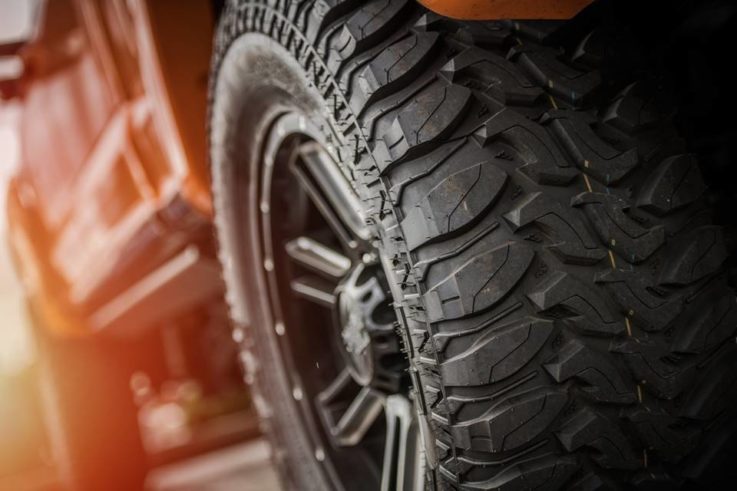Tires may be damaged due to various reasons, and they may happen without the driver immediately aware of the problem. In this section, we will explain the signs and symptoms to help you diagnose the problem, as well as some useful tips on how to prevent it. Recognizing irregular wear There are many types of irregular wear. The most typical changes are heel and toe wear, one side wear, and center wear. Here we explain how and why they happen. one. Heel and Toe Wear Heel and Toe Wear is a pattern caused by normal wear and tear and suspension adjustments. It is the externally visible (and audible) manifestation of the various torsional forces acting on the tread.
To explain it in more detail, let’s understand the tread design in more depth. travels long distances on straight roads at a constant speed; moderate riding style camber and suspension geometry alignment. When the tire rolls on the road, the independent block deforms as it approaches the contact area of the tire and compresses when it comes into contact with the asphalt. However, once they lose contact with the road, the blocks will return to their original shape and rub the surface while doing so. The result is that wear patterns appear on the beating edges of the block, and are more likely to appear in the non-driving wheel position. Feather central wear You can find this pattern of wear on the drive wheels of highly maneuverable cars.
During vigorous acceleration, in city traffic, but new from Tyre Shop UAE, or when accelerating away from traffic lights, these high levels of torque can rapidly increase wear in the center of the tread. Even today’s mid-range vehicles are equipped with modern engines that can produce high levels of torque and can produce high levels of slip. Single side wear at degrees Celsius the biggest cause of single side wear at is shaft geometry. Deviations can develop over time and are, for example, the result of aggressive curb installation. Lowering the vehicle height and low-profile tires will also affect wheel alignment.
The improved suspension arm often makes the wheel alignment deviate from the designated position. This problem may surprise the driver because the wheel alignment value is still within tolerance when measuring the static position on the axle measuring table. However, the manufacturer’s calibration data applies to delivered vehicles, not necessarily to customized cars. As a result, uneven tread wear will increase as a result. If the vehicle’s wheels are misaligned, a qualified expert can correct the drift by realigning the wheels. Identify impact fracture or bulge Impact fracture is the damage to the carcass (tire carcass) caused by the tire contact with some obstacles. The obvious bumps on the sidewall of the tire indicate that the beads in the carcass are damaged.
This type of damage is usually caused by speeding or passing objects (such as curbs or speed bumps) at the wrong angle. Overloading of the enclosure can cause individual cables to break. The exact degree of damage will depend on the speed and angle of the impact and the size of the obstacle. A careful driver can usually avoid such damage unless an obstacle suddenly appears in front of the vehicle and cannot be avoided. Ignoring such damage will increase the risk of tire failure at some point in the future, delamination of the tread and plies, or disintegration of the tire sidewall.
Impact fracture is sometimes mistaken for a gap in the side wall, but they are not the same. As we explain below, pits or dents on the side wall are not the cause of the alarm. Identification of sidewall gaps the sidewalls of tires are not always exactly the same; sometimes dents and indentations may appear, and a more detailed inspection may be required to determine the cause. The important thing to know is that dents are harmless and will not impair driving or safety functions. The dimples are superficial. If you imagine attaching a rope to an inflated balloon and then gently pulling the rope with more force, you can best illustrate the dent in the tire. If the balloon is a tire, then the rope is a cord embedded in the carcass hidden by rubber, it’s means you need to tire change dubai. These cables provide strength and stability to the tires and transmit steering and braking forces while driving.
During the tire manufacturing process, or rather when building the carcass, where the steel belt and tread are attached to the carcass, there is usually one or two overlaps on the carcass. It is this overlap that sometimes looks like dents after the tire is installed and inflated. Identify cuts are the result of external influences, such as poor road conditions, protruding body parts, or sharp foreign objects such as stones or glass. If you find damage in the form of cuts on the tire surface, you should visit your local tire dealer and have your tire inspected by an expert immediately. Perforation explanation Perforation is caused by a sharp object on the road (such as nails, screws or broken glass) penetrating the surface of the tire.
If the puncture is deep enough, the tire may start to lose air pressure and start finding to Tyre Shops Near Me. If you find that one or more of your tires continue to lose pressure, or you find nails or screws embedded in the tread, please contact your local tire specialist for repair as soon as possible. Prevent damage. Regularly change the position of car tires (unless the vehicle manufacturer recommends otherwise) to promote uniform tire wear. The position of the tire must be rotate. By periodically turning the wheels from the driving axle to the non-driving axle, drivers can expect their tires to have a uniform wear pattern. But as always, follow the recommendations provided by the vehicle manufacturer. If you have to pass through an obstacle in the road, approach slowly and get as close to the vertical line as possible. Next, check your tires for external damage, such as cuts, cracks, or bulges. In addition, avoid active driving on unpaved roads.

